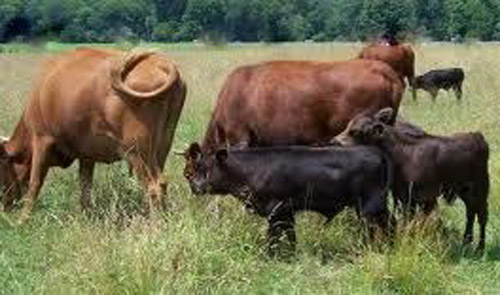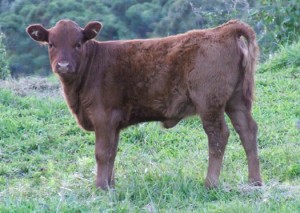Dexters are fascinating little cattle. People always have lots of questions about them. Listed below are some of the questions we have been asked most frequently. We have attempted to answer them for you.
Q. What colours do they come in?
A. Most of Dexter cattle are black but there are also red Dexters, while other Dexters are dun (many different shades of any brownish colour).
Q. Are they popular farm animals?
Yes, they are. Particularly with people living on small farms. They have a good nature and provide plenty of fresh meat and milk for the household.
Q. How much room do Dexter cattle need?
A. Generally you can run three to four Dexters on the same area as two Jerseys. We have a member who has nine Dexters on 3 hectares. If it gets dry they get some additional hay.
Q. Do they have horns?
Some of them do, others do not have horns and others have had their horns removed. Their horns are white with black tips.
Q. Where do Dexter cattle come from?
Dexter cattle originated in Ireland from an ancient breed of small mountain cattle.
Q. What do they eat?
A. They are not too fussy about what they eat. Unlike other cattle they will browse and forage on shrubs and weeds if grass is scarce.
For a copy of this page in PDF format: Frequently Asked Questions ll
Answers to some of the most Frequently Asked Questions relating to Dexter cattle and dwarfism or Chondrodysplasia.
Q. What is the difference between and short legged Dexter, and dwarf Dexter and a Dexter with “Chondrodysplasia”?
A. None. The terms, “short-legged”, “dwarf”, “dwarfism”, “Achondroplasia”, “Chondrodysplasia”, “bulldog gene”, “carrier” or all refer to the same entity. The terms “long-legged”, “medium-legged”, “non-dwarf”, “non short-legged”, “non-carrier” and “proportionate” all refer to the normal Dexter.
Q. If I mate my long legged Dexter with another long legged Dexter, can I ever get a short legged calf or a bulldog calf?
A. No
A. Only if you mate it with and short legged Dexter and in which case there is a 50% chance on the calf
being dwarf and a 50% chance of the calf being normal.
Q. Can my short legged Dexter have a bulldog calf?
A. Only if you mate it with another short legged Dexter in which case there is a 50% chance of the calf being dwarf, a 25% chance of the calf being nor-mal and a 25% chance of the foetus being aborted as a bulldog calf.
Q. If I mate a long legged Dexter with a short legged Dexter will I get a medium legged Dexter?
A. No. The term, medium legged often confuses the issue. a medium legged Dexter is simply a smaller normal Dexter, that is, a normal Dexter which is pro-portionate, but smaller
For a copy of this page in PDF format: Frequently Asked Questions
Newin Dexter Stud Policy
At Newinn Dexter Stud we want to breed a consistent herd and I believe it is negative to have a genetic fault in the herd. I want people who purchase Newinn Dexter’s to be confident in the consistency of the calves they breed. I also believe that it is important that prospective Dexter breeders should be fully informed of the situation with respect to this condition, to enable them to make informed purchasing/breeding decisions. At Newinn Dexter Stud I have decided to breed only normal Dexters and ensure that no outside bull used is a carrier of the dwarfism gene. Newinn Dexter Stud’s line of Dexters -bulls and cows-are within the height restrictions as laid down in the breed ideal. This line is based on Brayer Park Chantel who was 102 cm at the hip at three years of age. Though small, they have been DNA tested free of the dwarfism gene. Their small size means that they can be expected to breed true to size, since their size is not a result of dwarfism.

